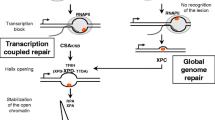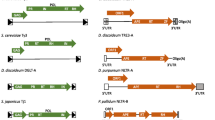Abstract
L1 LINE retrotransposons play a key role in the formation and sustainable evolution of mammalian genomes. In particular, L1 retrotransposons, which occupy approximately 20% of genomic DNA, transduce their 3′-flanking sequences to new genomic loci and create pseudogenes via reverse transcription of different types of cellular RNAs. Recently, we discovered several families of chimeric pseudogenes in mammalian genomes consisting of fused copies of various cellular transcripts. Characteristic features of such chimeric inserts are indicative of the involvement of L1 enzymatic machinery in their formation. A detailed sequence analysis showed that the 5′-terminal parts of the chimeras were copies of nuclear RNAs, whereas the 3′-terminal parts were formed on the templates of transcripts that have a cytoplasmic location. A mechanism of chimera formation, including a switch of templates during RNA reverse transcription catalyzed by L1 reverse transcriptase, is proposed. The presence in the mammalian genome of not only “double” but also “triple” chimeric retrogenes indicates that not only a single but also a double template switch may occur during L1-catalyzed reverse transcription. Some of the chimeras identified were transcriptionally active, which allowed us to regard the discovered phenomenon as a new mechanism of gene formation by “shuffling” preexisting transcribed sequences. This mechanism currently functions in mammalian genomes; it appeared at least 75 million years ago and is evolutionarily conserved.
Similar content being viewed by others
REFERENCES
McClintock B. 1956. Controlling elements and the gene. Cold Spring Harbor Symp. Quant. Biol. 21, 197–216.
Wessler S.R. 1998. Transposable elements and the evo-lution of gene expression. Symp. Soc. Exp. Biol. 51, 115–122.
Kapitonov V., Jurka J. 2003. Molecular paleontology of transposable elements in the Drosophila melanogaster genome. Proc. Natl. Acad. Sci. USA. 100, 6569–6574.
International Human Genome Sequencing Consortium. 2001. Initial sequencing and analysis of the human genome. Nature. 409, 860–921.
Baltimore D. 1970. RNA-dependent DNA polymerase in virions of RNA tumour viruses. Nature. 226, 1209–1211.
Urnovitz H.B., Murphy W.H. 1996. Human endogenous retroviruses: Nature, occurrence, and clinical implications in human disease. Clin. Microbiol. Rev. 9, 72–99.
Finnegan D.J. 1997. Transposable elements: How non-LTR retrotransposons do it. Curr. Biol. 7, 245–248.
Pyatkov K.I., Arkhipova I.R., Malkova N.V., Finnegan D.J., Evgen’ev M.B. 2004. Reverse transcriptase and endonuclease activities encoded by Penelope-like retroelements. Proc. Natl. Acad. Sci. USA. 101, 14719–14724.
Schmid C.W. 1998. Does SINE evolution preclude Alu function? Nucleic Acids Res. 26, 4541–4550.
Temin H.M. 1993. Retrovirus variation and reverse transcription: Abnormal strand transfers result in retrovirus genetic variation. Proc. Natl. Acad. Sci. USA. 90, 6900–6903.
Malik H.S., Eickbush T.H. 2001. Phylogenetic analysis of ribonuclease H domains suggests a late, chimeric origin of LTR retrotransposable elements and retroviruses. Genome Res. 11, 1187–1197.
Eickbush T.H. 1997. Telomerase and retrotransposons: Which came first? Science. 277, 911–912.
Pardue M.L., DeBaryshe P.G. 2003. Retrotransposons provide an evolutionarily robust non-telomerase mechanism to maintain telomeres. Annu. Rev. Genet. 37, 485–511.
Buzdin A.A. 2004. Retroelements and formation of chimeric retrogenes. Cell. Mol. Life Sci. 61, 2046–2059.
Mizrokhi L.J., Georgieva S.G., Ilyin Y.V. 1988. Jockey, a mobile Drosophila element similar to mammalian LINEs, is transcribed from the internal promoter by RNA polymerase II. Cell. 54, 685–691.
Birnstiel M.L., Busslinger M., Strub K. 1985. Transcription termination and 3′ processing: The end is in site! Cell. 41, 349–359.
Eickbush T.H. 1992. Transposing without ends: The non-LTR retrotransposable elements. New Biol. 4, 430–440.
Kazazian H.H. 2004. Mobile elements: Drivers of genome evolution. Science. 303, 1626–1632.
Brosius J. 1999. RNAs from all categories generate retrosequences that may be accepted as novel genes or regulatory elements. Gene. 238, 115–134.
Pickeral O.K., Makalowski W., Boguski M.S., Boeke J.D. 2000. Frequent human genomic DNA transduction driven by LINE-1 retrotransposition. Genome Res. 10, 411–415.
Goodier J.L., Ostertag E.M., Kazazian H.H. 2000. Transduction of 3′-flanking sequences is common in L1 retrotransposition. Hum. Mol. Genet. 9, 653–657.
Buzdin A., Ustyugova S., Gogvadze E., Lebedev Y., Hunsmann G., Sverdlov E. 2003. Genome-wide targeted search for human specific and polymorphic L1 integrations. Hum. Genet. 112, 527–533.
Brouha B., Schustak J., Badge R.M., Lutz-Prigge S., Farley A.H., Moran J.V., Kazazian H.H. 2003. Hot L1s account for the bulk of retrotransposition in the human population. Proc. Natl. Acad. Sci. USA. 100, 5280–5285.
Furano A.V. 2000. The biological properties and evolutionary dynamics of mammalian LINE-1 retrotransposons. Prog. Nucleic Acid. Res. Mol. Biol. 64, 255–294.
Kolosha V.O., Martin S.L. 2003. High-affinity, non-sequence-specific RNA binding by the open reading frame 1 (ORF1) protein from long interspersed nuclear element 1 (LINE-1). J. Biol. Chem. 278, 8112–8117.
Wei W., Gilbert N., Ooi S.L., Lawler J.F., Ostertag E.M., Kazazian H.H., Boeke J.D., Moran J.V. 2001. Human L1 retrotransposition: cis preference versus trans complementation. Mol. Cell. Biol. 21, 1429–1439.
Dewannieux M., Esnault C., Heidmann T. 2003. LINE-mediated retrotransposition of marked Alu sequences. Nature Genet. 35, 41–48.
Esnault C., Maestre J., Heidmann T. 2000. Human LINE retrotransposons generate processed pseudogenes. Nature Genet. 24, 363–367.
Buzdin A., Gogvadze E., Kovalskaya E., Volchkov P., Ustyugova S., Illarionova A., Fushan A., Vinogradova T., Sverdlov E. 2003. The human genome contains many types of chimeric retrogenes generated through in vivo RNA recombination. Nucleic Acids Res. 31, 4385–4390.
Buzdin A., Ustyugova S., Gogvadze E., Vinogradova T., Lebedev Y., Sverdlov E. 2002. A new family of chimeric retrotranscripts formed by a full copy of U6 small nuclear RNA fused to the 3′ terminus of L1. Genomics. 80, 402–406.
International Mouse Genome Sequencing Consortium. 2002. Initial sequencing and comparative analysis of the mouse genome. Nature. 420, 520–562.
Goodier J.L., Ostertag E.M., Engleka K.A., Seleme M.C., Kazazian H.H. 2004. A potential role for the nucleolus in L1 retrotransposition. Hum. Mol. Genet. 13, 1041–1048.
Giles K.E., Caputi M., Beemon K.L. 2004. Packaging and reverse transcription of snRNAs by retroviruses may generate pseudogenes. RNA. 10, 299–307.
Gogvadze, E.V., Buzdin, A.A., and Sverdlov, E.D., 2005. Template switch during LINE-mediated reverse transcription is the most probable mechanism of the formation of double and triple chimeric retroelements in mammals. Bioorg. Khim. (in press).
Bibillo A., Eickbush T.H. 2002. The reverse transcriptase of the R2 non-LTR retrotransposon: Continuous synthesis of cDNA on non-continuous RNA templates. J. Mol. Biol. 316, 459–473.
Negroni M., Buc H. 2001. Mechanisms of retroviral recombination. Annu. Rev. Genet. 35, 275–302.
Kandel E.S., Nudler E. 2002. Template switching by RNA polymerase II in vivo. Evidence and implications from a retroviral system. Mol. Cell. 10, 1495–1502.
Swanstrom R., Parker R.C., Varmus H.E., Bishop J.M. 1983. Transduction of a cellular oncogene: the genesis of Rous sarcoma virus. Proc. Natl. Acad. Sci. USA. 80, 2519–2523.
Jamain S., Girondot M., Leroy P., Clergue M., Quach H., Fellous M., Bourgeron T. 2001. Transduction of the human gene FAM8A1 by endogenous retrovirus during primate evolution. Genomics. 78, 38–45.
Author information
Authors and Affiliations
Additional information
__________
Translated from Molekulyarnaya Biologiya, Vol. 39, No. 3, 2005, pp. 364–373.
Original Russian Text Copyright © 2005 by Gogvadze, Buzdin.
Rights and permissions
About this article
Cite this article
Gogvadze, E.V., Buzdin, A.A. A New Mechanism of Retrogene Formation in Mammalian Genomes: In Vivo Recombination during RNA Reverse Transcription. Mol Biol 39, 321–330 (2005). https://doi.org/10.1007/s11008-005-0045-5
Received:
Issue Date:
DOI: https://doi.org/10.1007/s11008-005-0045-5




